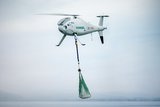Skunk Works tests Project Hydra
Project Hydra. (Photo: Lockheed Martin)
Lockheed Martin Skunk Works, working with the Missile Defense Agency and the USAF, successfully tested Project Hydra.
The test involved using an Open Systems Gateway payload onboard a U-2 to link an F-22 to five F-35s via native Intra-Flight Data Link and Multifunction Advanced Data Link.
The target tracks were also transmitted by and through the U-2 into the fighter avionics and pilot displays.
This enabled successful data sharing between all airborne aircraft and the nodes on the ground.
Jeff Babione, VP and GM of Lockheed Martin Skunk Works, said: ‘Project Hydra marks the first time that bi-directional communications were established between 5th Generation aircraft in-flight, while also sharing operational and sensor data down to ground operators’.
Project Hydra also marked the first time that F-35 sensor data was delivered to an operational ground system over a Tactical Network Terminal link using an airborne gateway.
This data was then sent to the US Army Integrated Battle Command System (IBCS) Airborne Sensor Adaptation Kit (A-Kit), which was also developed by Lockheed Martin.
The A-Kit then transmitted data to the IBCS Tactical System Integration Laboratory. IBCS used the data to conduct a simulated Army fires exercise.
As part of our promise to deliver comprehensive coverage to our Defence Insight and Premium News subscribers, our curated defence news content provides the latest industry updates, contract awards and programme milestones.
Related Equipment in Defence Insight
More from Air Warfare
-
![US Air Force has big plans for the F-47]()
US Air Force has big plans for the F-47
The USAF Chief of Staff has claimed that the sixth-generation fighter would allow for guaranteeing “air superiority for generations to come”.
-
![India and France seal Rafale-M deal as plans for local assembly advance]()
India and France seal Rafale-M deal as plans for local assembly advance
Inter-governmental agreement signed as final assembly line plans inch closer.
-
![Just Released: New UAS Technology Report now available to read]()
Just Released: New UAS Technology Report now available to read
Autonomous advantage: Unlocking the potential of VTOL UAS in the battlefield resupply role
-
![Update: India’s Rafale-M deal postponed]()
Update: India’s Rafale-M deal postponed
New Delhi had been gearing up to sign a Navy Rafale deal as talks swirled around a potential assembly line in Nagpur.
-
![Turkey’s Eurofighter process going to plan despite German block, says minister]()
Turkey’s Eurofighter process going to plan despite German block, says minister
The comment, made by Turkish defence minister Yasar Guler, also noted that the 40-strong sale of Eurofighter Typhoons was primarily managed by the UK, not Germany.
-
![Airbus awaits USMC decision on Logistics Connector programme]()
Airbus awaits USMC decision on Logistics Connector programme
Airbus has been advancing development of its uncrewed MQ-72C Logistics Connector for the US Marine Corps, with a decision on the programme expected in early 2026.
























